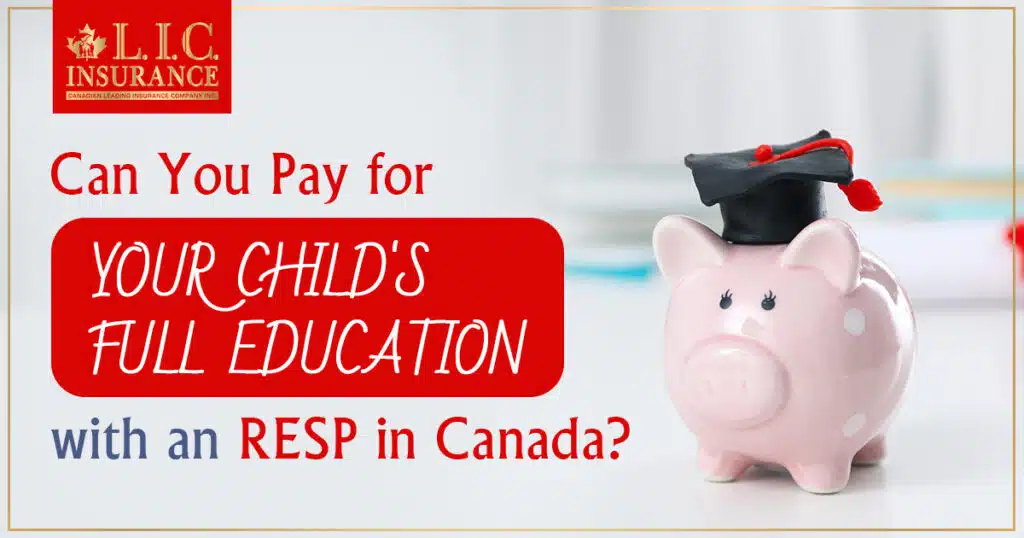
As parents, we often dream of providing the best possible education for our children. In Canada, post-secondary education costs continue to rise, making it a significant financial consideration for many families. To help parents save for their children’s education, the Canadian government introduced the Registered Education Savings Plan (RESP). But the main question is: Can you pay for your child’s entire education with an RESP in Canada? This blog will help you understand RESP, its benefits, limitations, strategies to make the most of this savings tool, and most importantly can help to pay for the full education of your child or not.
A Brief Overview of RESP
The Registered Education Savings Plan (RESP) is a tax-advantaged savings plan designed to help parents save for their children’s post-secondary education. RESP has now become an essential tool for Canadian parents looking to invest in their children’s future. Key features of an RESP include:
- Tax Advantages: Contributions to an RESP are not tax-deductible, but the investment grows tax-deferred until withdrawn for educational purposes. When the funds are used for education, the earnings are taxed at the beneficiary’s (the student’s) lower tax rate.
- Canada Education Savings Grant (CESG): The government provides additional support in the form of the CESG, which matches a percentage of your contributions. This grant significantly boosts your savings.
- Canada Learning Bond (CLB): The government offers the CLB for lower-income families, providing an initial contribution and additional funds annually until the beneficiary turns 15.
- Flexible Investment Options: RESPs offer a variety of investment options, including mutual funds, GICs, and stocks. This flexibility allows you to choose investments that align with your risk tolerance and financial goals.
- Lifetime Contribution Limit: There is a lifetime contribution limit of $50,000 per beneficiary. While this may not cover the entire cost of education, it provides a substantial head start.
Read More – why to choose an RESP
The RESP’s Potential to Cover Educational Costs
While RESPs offer significant benefits for saving for education, managing expectations is essential. Here’s a breakdown of the RESP’s potential to cover educational costs:
Related Posts
- Why Should You Use An Insurance Broker To Purchase An Insurance Plan?
- Why Should You Use An Insurance Broker To Purchase An Insurance Plan?
- Why Should You Use An Insurance Broker To Purchase An Insurance Plan?
- Why Should You Use An Insurance Broker To Purchase An Insurance Plan?
- Tuition and Fees: Depending on the program and institution, tuition and fees can vary widely in Canada. An RESP, especially when coupled with government grants, can help cover a significant portion of these costs. However, it’s unlikely to cover the entire expense.
- Books and Supplies: RESPs can also be used to pay for books, supplies, and other education-related expenses. These costs can add up, but an RESP can help to reduce the burden.
- Room and Board: If your child plans to live on campus or rent an apartment while studying, an RESP can contribute to these expenses. However, it may not cover the full cost, especially in high-cost cities like Vancouver or Toronto.
- Transportation: If your child needs to commute to the educational institution, RESP funds can be used for transportation costs. Again, the coverage will depend on the distance and mode of transportation.
- Other Expenses: Miscellaneous expenses, such as a computer, software, or even a part-time job, can also be funded with RESP withdrawals.
Strategies to Maximize Your RESP’s Value
To make the most of your RESP and increase its potential to cover educational costs, consider these strategies:
- Begin Early: Your investments will have more time to grow the earlier you begin making contributions to a RESP. Over time, compound interest can considerably increase your savings.
- Participate frequently: Make recurring contributions to your RESP to guarantee steady growth. To stay on track, many parents decide to make a monthly or yearly contribution.
- Maximize Government Grants: For increasing government grants use the Canada Education Savings Grant (CESG) and Canada Learning Bond (CLB) to your advantage by making the highest annual contribution permitted to get the full grant amounts.
- Invest Smartly: Choose your RESP investments wisely based on your time horizon and risk tolerance. Your portfolio’s diversification can reduce risk.
- Think about family plans: If you have several kids, think about a family RESP. This enables you to divide money among siblings, maximizing the advantages.
- Understand the Withdrawal Policies: Learn about the regulations governing RESP withdrawals. Ensure that the school your child attends meets the requirements and that withdrawals are processed in a way that minimizes taxes.
- Encourage Your Child to Work Part-Time: Encourage your child to work part-time to help them pay their living expenses while they are in school. Withdrawals from a RESP can be combined with earnings from a part-time job.
- Explore Scholarships and Bursaries: Encourage your child to apply for scholarships and bursaries, which can help reduce the cost of their education.
- Examine Additional Funding Sources: Investigate alternative funding sources, including student loans or credit lines, if your RESP cannot pay all of your expenses.
Get The Best Insurance Quote From Canadian L.I.C
Call 1 844-542-4678 to speak to our advisors.
RESP Rules and Regulations
While RESPs are a valuable tool for saving for education, it’s essential to be aware of their limitations and considerations:
- Lifetime Contribution Limit: The lifetime contribution limit of $50,000 per beneficiary may not cover the full cost of a four-year university program, especially in high-cost regions.
- Market Volatility: RESP investments are subject to market fluctuations. While they offer growth potential, there is also a risk of losing money, especially if investments are overly aggressive.
- Withdrawal Rules: Funds must be used for eligible educational expenses, and there are specific rules governing withdrawals. Make sure you understand these rules to avoid penalties.
- Unused RESP Funds: If your child decides not to pursue post-secondary education or if they receive a full scholarship, you may face penalties when withdrawing RESP funds. However, there are ways to mitigate these penalties.
- Impact on Financial Aid: Large RESP balances can impact your child’s eligibility for financial aid. It’s important to consider this when planning your contributions.
- No Tax Deduction for Contributions: Unlike RRSPs (Registered Retirement Savings Plans), contributions to an RESP are not tax-deductible, which means you don’t get an immediate tax benefit.
Read More – RESP here
The big question: Would RESP cover all higher education costs?
Now, we come to the main part of this blog. Whether or not the RESP account you have started would cover the complete costs. At Canadian LIC, we use a special calculator which takes into account factors such as the annual rise in tuition costs and the growth of annual investments. Another factor is, if your family income is more than $47,630 then you won’t be eligible for the Canada Learning Bond. So, to max out the CESG grants received, you will have to contribute $2500 annually.
So, if the total education cost is $83,504.02, then on a planned contribution of $2500 the lifetime saved amount would be $100,092.14. This lump sum amount is a combination of your contributions, the CESG grants, and investment return. You will save at least $16,588.12 by the end of the final year.
In other words, if you start saving early for your child’s education, then the RESP account will be more than sufficient. If you have any queries, feel free to get in touch. Don’t wait anymore, take advantage of the government’s free grants and open an RESP account today!
Get The Best Insurance Quote From Canadian L.I.C
Call 1 844-542-4678 to speak to our advisors.

Coming to The End
To sum up, a Registered Education Savings Plan (RESP) is an excellent way for Canadian parents to start saving for their child’s post-secondary education. Even though it might not completely cover the expense of education, it offers a strong foundation and can significantly ease the financial strain. You may get the most out of your RESP by getting started early, taking advantage of government assistance, and making wise investment choices. However, in order to make sure that your child’s educational goals come true, it’s critical to be aware of the program’s restrictions and take into account other funding options. An RESP can be a potent tool in safeguarding your child’s educational future in Canada with careful planning and diligent saving.
FAQ’s
So now let’s get the answers to some frequently asked questions (FAQs) related to paying for your child’s full education with an RESP in Canada:
While an RESP can provide substantial financial support, it’s unlikely to cover the entire cost of your child & education, especially if they pursue a long and expensive program or study in a high-cost city. However, it can significantly ease the financial burden.
If your child decides not to pursue post-secondary education, you have a few options. You can transfer the RESP to another eligible beneficiary within the family, postpone withdrawals until your child changes their mind, or withdraw the contributions without penalty. However, government grant money may need to be returned or forfeited in certain situations
It’s generally recommended to purchase travel insurance before your trip begins. However, some insurance providers may offer options to Yes, there are specific rules governing RESP withdrawals. Funds must be used for eligible educational expenses, and you must provide proof of enrollment. Be aware of these rules to avoid penalties.
Yes, you can open a family RESP that allows you to allocate funds between siblings. This is a convenient way to manage savings for multiple children.
You can still use your RESP funds if your child receives a scholarship or other financial aid. However, you may need to repay government grant money or consider other options for using the RESP funds without penalty.
Yes, RESP funds may be applied to eligible postsecondary programs offered outside of Canada. However, it’s crucial to confirm that the institution and program satisfy the requirements for eligibility.
An RESP can be used to hold equity investments, such as mutual funds, individual stocks, and bonds, as well as fixed-income products. With the assistance of a Canadian LIC expert, you can decide which set of investments will perform the best for you.
A Registered Education Savings Plan accepts a limitless number of contributions each year. The maximum annual contribution per recipient is $50,000, though. (Your plan may have more than $50,000 in it until the time comes for your child to use it because government grants and investment growth in your RESP are not counted toward the $50,000 limit.
There is no time restriction. Contributions to a RESP are welcome at any time of the year. When requesting government support, use the calendar year.
If you want to take money out of a RESP, you might need to show the bank your receipts for purchases like laptops and books. Additionally, you need to demonstrate that the beneficiary is registered in an acceptable post-secondary program.
You are only qualified for $5,000 in payments from a RESP’s investment growth during the first 13 weeks of enrolment, in addition to any Canada Education Savings Grants, provincial grants, or Canada Learning Bonds (the educational assistance payment). After that, provided the payment is appropriate, you are entitled to any amount of payment. You can withdraw as much of your personal plan contributions as you want whenever you’d like.
In order to qualify for the CESG, beneficiaries who are 16 or 17 years old must fulfill certain contribution requirements. RESPs with beneficiaries aged 16 and 17 may be eligible for the CESG if at least one of the following two conditions is met:
- Before the conclusion of the beneficiary’s 15th birthday, at least $2,000 was deposited into their RESP; this money was not withdrawn.
- A minimum of $100 was paid to the RESP each year (and was not taken out of it) in any of the four years before the end of the calendar year that the beneficiary turned 15.
Yes, you are able to start a RESP for yourself. However, if you are 18 or older, a TFSA might be better than a RESP for you.
With the help of a Canadian LIC advisor, you may assess which type of account is best for your requirements.
The above information is only meant to be informative. It comes from Canadian LIC’s own opinions, which can change at any time. This material is not meant to be financial or legal advice, and it should not be interpreted as such. If someone decides to act on the information on this page, Canadian LIC is not responsible for what happens. Every attempt is made to provide accurate and up-to-date information on Canadian LIC. Some of the terms, conditions, limitations, exclusions, termination, and other parts of the policies mentioned above may not be included, which may be important to the policy choice. For full details, please refer to the actual policy documents. If there is any disagreement, the language in the actual policy documents will be used. All rights reserved.
Please let us know if there is anything that should be updated, removed, or corrected from this article. Send an email to [email protected] or [email protected]

